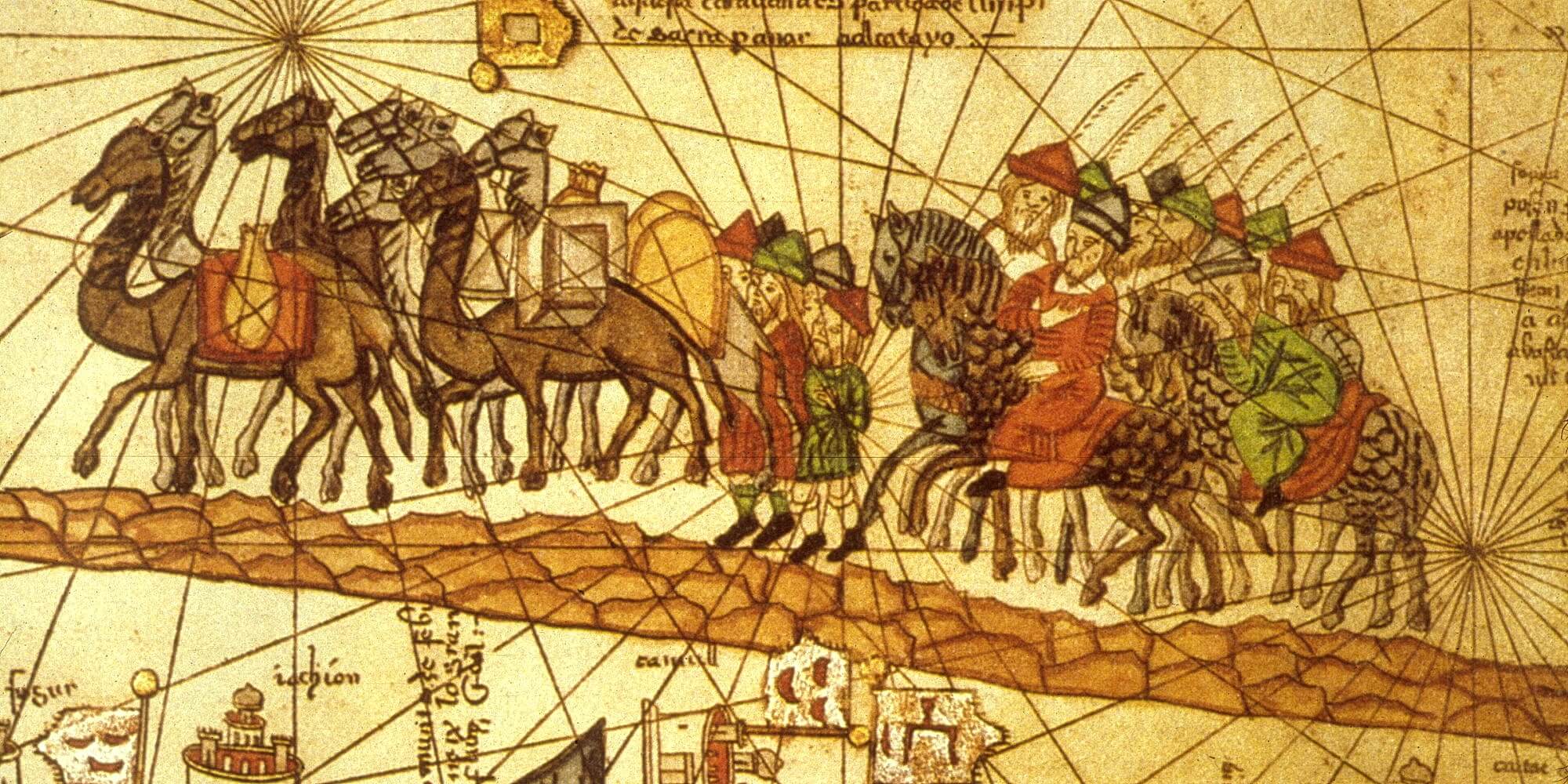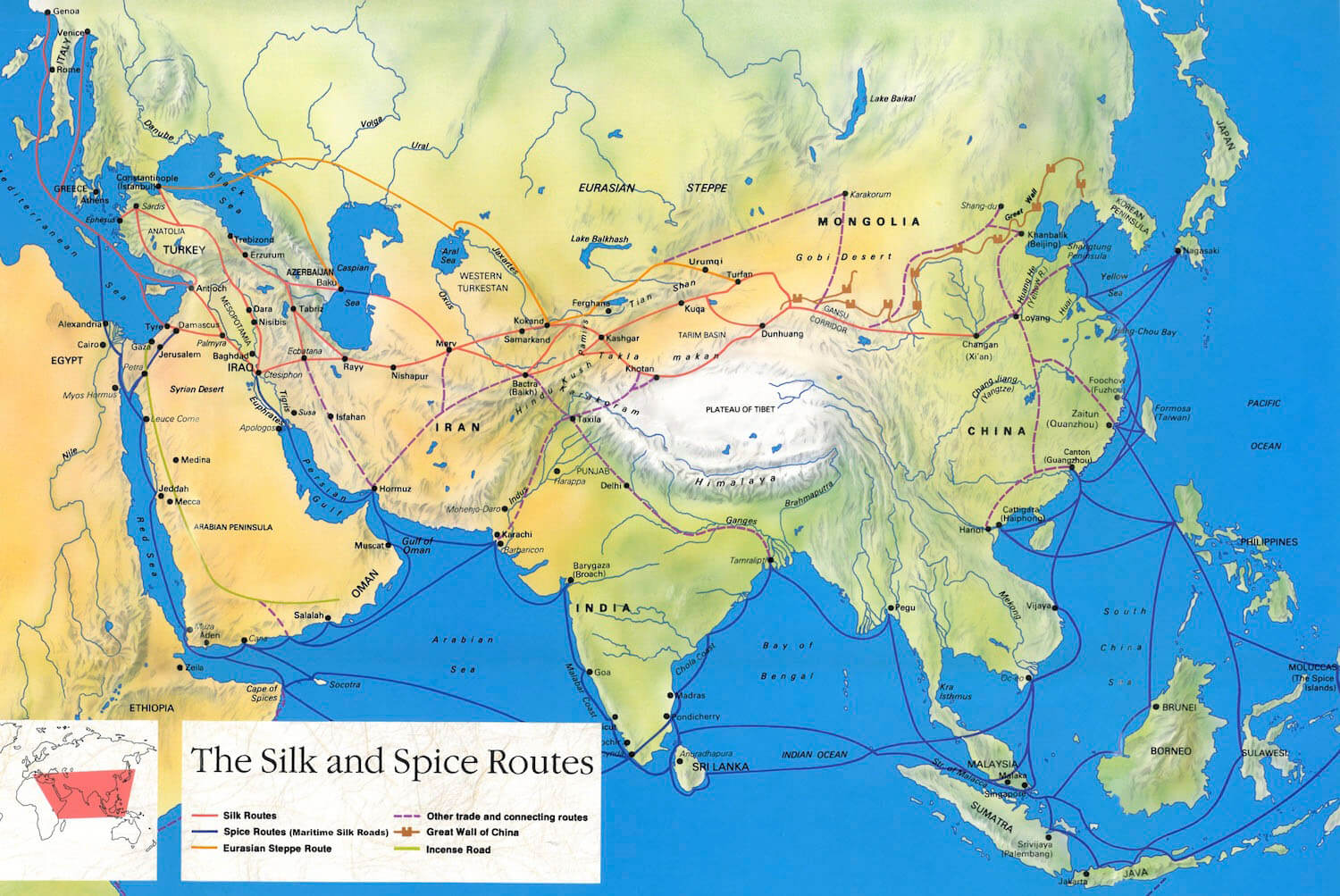
THE OLD SILK ROAD
ANNO 600 BCE
The old Silk Road was an ancient network of trade routes that connected the East and West. Two way trade on the Road played a significant role in the connecting of civilizations of China, Korea, Japan, the Indian subcontinent, Persia, Europe, the Horn of Africa and Arabia. There were both the overland and the sea routes connecting East Asia and Southeast Asia with East Africa, West Asia and Southern Europe.
It is generally accepted that the international trade in Silk flourished during the Chinese Han dynasty (207-220CE) although Chinese silk dating from around 1000 BCE has been found in some burial sites of ancient Egypt. A 6th century BCE burial site near Stuttgart, Germany was excavated and contained not only Greek bronzes but also Chinese silks.

Chinese and Central Asian contacts
Central Eurasia was famous since ancient times for its horse riding and horse breeding communities Archeological sites such as the Berel burial ground in Kazakhstan, confirmed that the nomadic Arimaspians were not only breeding horses for trade but also great craftsmen able to propagate exquisite art pieces along the Silk Road. From about 2000 BCE, nephrite jade was being traded from mines in the region of Yarkand and Khotan to China. These mines were not very far from the lapis lazuli and spinel mines in Badakhshan, and trading routes were in use from very early times.
Following contacts between Metropolitan China and nomadic western border territories in the 8th century BCE, gold was introduced from Central Asia, and Chinese jade carvers began to make imitation designs of the steppes, adopting the Scythian-style animal art of the steppes (depictions of animals locked in combat.
The expansion of Scythian cultures, stretching from the Hungarian plain and the Carpathian Mountains to the Chinese Kansu Corridor, and linking the Middle East with Northern India and the Punjab, played an important role in the development of the Silk Road. Nomads everywhere also encouraged long-distance merchants as a source of income through the enforced payment of tariffs. Sogdians played a major role in facilitating trade between China and Central Asia along the Silk Roads as late as the 10th century, their language serving as a lingua franca for Asian trade as far back as the 4th century.
By the time of Herodotus (c. 475 BCE), the Royal Road of the Persian Empire ran some 2,857 km from the city of Susa on the Karun (250 km) east of the river Tigris) to the port of Smyrna (now İzmir in Turkey) on the Aegean Sea. It had postal stations and relays at regular intervals. By having fresh horses and riders ready at each relay, royal couriers could carry messages and traverse the length of the road in nine days, while regular travelers took about three months.
Hellenistic era
The next major step in the development of the Silk Road was the expansion of the Greek empire of Alexander the Great into Central Asia. In August 329 BC, at the mouth of the Fergana Valley in Tajikistan, he founded the city of Alexandria Eschate
The Greeks remained in Central Asia for the next three centuries, and then with the establishment of the Greco-Bactrian Kingdom (250–125 BCE) in Bactria (modern Afghanistan, Tajikistan, and Pakistan) and the later Indo-Greek Kingdom (180 BCE – 10 CE) in modern Northern Pakistan and Afghanistan. They continued to expand eastward, especially during the reign of Euthydemus (230–200 BCE), who extended his control beyond Alexandria Eschate to Sogdiana. There are indications that he may have led expeditions as far as Kashgar in Chinese Turkestan, leading to the first known contacts between China and the West around 200 BCE.
With the Mediterranean linked to the Fergana Valley, the next step was to open a route across the Tarim Basin and the Hexi Corridor to China Proper. Around 130 BCE the Silk Route was as a major avenue of international trade. Chinese Emperor Wu became interested in developing commercial relationships with the sophisticated urban civilizations of Ferghana, Bactria, and the Parthian Empire: "The Son of Heaven on hearing all this reasoned thus: Ferghana (Dayuan "Great Ionians") and the possessions of Bactria (Ta-Hsia) and Parthian Empire (Anxi) are large countries, full of rare things, with a population living in fixed abodes and given to occupations somewhat identical with those of the Chinese people, and placing great value on the rich produce of China".
The nomads living on the Silk route wanted only agricultural produces societies produced by societies on the silk road , such as grain and silk. Even after the construction of the Chinese Great Wall, nomads gathered at the gates of the wall to exchange produce, art and crafts. China's control of the Silk Road at the time of the later Han, ensured the freedom of transcontinental trade along the double chain of oases north and south of the Tarim, and the dissemination of Buddhism in the river basin, and with it Indian literature and Hellenistic art.
The Chinese were also strongly attracted by the tall and powerful horses (named "Heavenly horses") in the possession of the Dayuan, the “Great Ionians", the Greek kingdoms of Central Asia, The Chinese subsequently sent numerous embassies, around ten every year, to these countries and as far as Seleucid Syria. These connections marked the beginning of the Silk Road trade network that extended to the Roman Empire. It has been suggested that the Chinese crossbow was transmitted to the Roman world via the Silk road. The Roman historian Florus also describes the visit of numerous envoys, which included Seres(China), to the first Roman Emperor Augustus, who reigned between 27 BCE and 14 CE:
THE MARITIME SILK ROAD
ANNO 600 BCE
Chinese silk dating from around 1000 BCE has been found in some burial sites of ancient Egypt. The maritime Silk Road was a conduit for trade and cultural exchange between China's south-eastern coastal areas and foreign countries. There were two major routes: the East China Sea Silk Route and the South China Sea Silk Route
Starting from Guanzhou Fujian Province, the maritime Silk Road was the earliest voyage route that was formed in the Qin and Han dynasties, developed from the Three Kingdoms Period to the Sui Dynasty, flourished in the Tang and Song dynasties, and fell into decline in the Ming and Qing dynasties.
Through the maritime Silk Road, silks, “China” porcelain, tea, brass and iron were the four main exports to foreign countries; while spices, flowers and plants, and rare treasures for the court were brought to China.

Map of the Maritime Silk Road
The East China Sea Silk Route
The East China Sea Silk Route mainly terminated in Japan and Korea. It dates back from the Zhou Dynasty (1112 BC) when the government sent some Chinese people to Korea to teach farming and sericulture, departing from the port of Bohai Bay, at the Shandong Peninsula.
From that time, the skills and techniques of raising silkworms, silk reeling and weaving were introduced into Korea.
When Emperor Qin Shi Huang united China (221 BC), many people from the defeated States of Qi, Yan and Zhao fled to Korea and took with them silkworms and silkworm raising technology, which accelerated the development of silk spinning and weaving in Korea.
During the Sui and Tang dynasties, Japanese envoys and monks travelled frequently to China. They returned with blue damask silks from. Since the Tang Dynasty, silk products from Jiangsu and Zhejiang provinces were directly transported to Japan by sea.
Many silk products were exported to Japan during the Song dynasty. During the Yuan Dynasty, the government set up Customs offices (Shi Bo Si) in many ports, such as Ningbo, Quanzhou, Guangzhou, Shanghai, Ganpu Wenzhou, and Hangzhou, in order to export the silk products to Japan.
Shi Bo Si's Oceangoing and Marketing Department, was set up in each port to administrate foreign economy-related affairs by sea during the dynasties of Tang, Song and Yuan, and the early part of the Ming Dynasty.
The maritime Silk Road fell into decline because of the Haijin policy of the Qing Dynasty. The Haijin policy was a ban on maritime activities imposed during the Ming and Qing dynasties.
The South China Sea Silk Route
The South China Sea Silk Route was an important conduit for China's exchanges with the outside world. The South China Sea Silk Route got its name for being centered on the South China Sea, and its starting points at that time were mainly in Guangzhou, Quanzhou and Ningbo.
Like the East China Sea Silk Route, it was first used in the Qin and Han dynasties, increased its popularity from the Three Kingdoms Period to the Sui Dynasty, flourished in the Tang and Song dynasties, and began to wane during the Ming and Qing dynasties.
During the period of the Sui and Tang dynasties, the overland Silk Road was severed because of wars in the western areas, and had to be substituted by the maritime Silk Road.
In the late Tang and Song dynasties, technological advances in shipbuilding and navigation led to the opening of new sea lanes to Southeast Asia, Malacca, the Indian Ocean, the Red Sea and the continent of Africa, and the subsequent flourishing of the maritime Silk Road.
Main Harbours
The main harbors of the maritime Silk Road varied with time. From the 330s, Guangzhou and Hepu were the two important harbors. However, Guangzhou was substituted by Quanzhou from the late Song Dynasty to the Yuan Dynasty.
Quanzhou in Fujian Province, together with Alexandria of Egypt, was considered to be the largest harbor in the world at that time. Due to the Haijin policy imposed in the early part of the Ming Dynasty and the influence of wars, Quanzhou was gradually replaced by Yuegang Harbour, Zhangzhou, Fujian.
Guangzhou was a great harbor in the maritime Silk Road from the 330s which became the largest one and the Oriental port known to the rest of the world in the Tang and Song dynasties. During that period, the voyage route from Guangzhou to the Persian Gulf through the South China Sea, Indian Ocean, was the longest one in the world.
Although it was later substituted by Quanzhou in the Yuan Dynasty, it was still the second largest trade port in China. Compared with other seaports, Guangzhou was an enduringly prosperous maritime city during some 2,000 years of the maritime Silk Road.
Even in periods of the early Ming and early Qing dynasties, Guangzhou was the only harbor open to foreign countries, and there were three voyage routes starting from it. The American vessel Empress of China first sailed to Guangzhou in 1784, opening the transportation route between America and Guangzhou.
The Huaisheng Mosque, also known as the Lighthouse Mosque, was the earliest mosque introduced by Islam into China. Hualin Temple was the place where Zen, a school of Mahayana Buddhism was introduced into China, and the place where Dharma preached his religion, and thus the temple was also called Xi Lai Chu Di.
